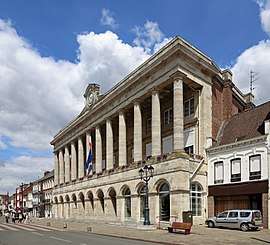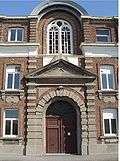Hazebrouck
| Hazebrouck Hazebroek | ||
|---|---|---|
| Commune | ||
 Town hall | ||
| ||
 Hazebrouck Location within Hauts-de-France region  Hazebrouck | ||
| Coordinates: 50°43′30″N 2°32′21″E / 50.725°N 2.5392°ECoordinates: 50°43′30″N 2°32′21″E / 50.725°N 2.5392°E | ||
| Country | France | |
| Region | Hauts-de-France | |
| Department | Nord | |
| Arrondissement | Dunkerque | |
| Canton | Hazebrouck | |
| Government | ||
| • Mayor (2008–2014) | Jean-Pierre Allossery | |
| Area1 | 26.2 km2 (10.1 sq mi) | |
| Population (1999)2 | 21,396 | |
| • Density | 820/km2 (2,100/sq mi) | |
| Demonym(s) | Hazebrouckois | |
| Time zone | UTC+1 (CET) | |
| • Summer (DST) | UTC+2 (CEST) | |
| INSEE/Postal code | 59295 /59190 | |
| Elevation |
17–66 m (56–217 ft) (avg. 23 m or 75 ft) | |
| Website | www.ville-hazebrouck.fr | |
|
1 French Land Register data, which excludes lakes, ponds, glaciers > 1 km2 (0.386 sq mi or 247 acres) and river estuaries. 2 Population without double counting: residents of multiple communes (e.g., students and military personnel) only counted once. | ||
Hazebrouck (Dutch: Hazebroek) is a commune in the Nord department in northern France. Hazebrouck in Flanders was a small market town before it became an important railway junction in the 1860s. West Flemish was the usual popular language used in the town until 1880. At that time French was taught at school by mandate of the French government in an effort to "Frenchify" the people of the Nord-Pas-de-Calais and to extinguish their Flemish roots. The development of the railways linked Hazebrouck to Lille to Calais and Dunkirk.
History
The incorporation into France of what had previously been a Flemish town was ratified in the 1678 Treaties of Nijmegen.
Hazebrouck's town hall was built in the 19th century and the oldest monument of the town is St Eloi's church. During the two world wars Hazebrouck was an important military target. Many British soldiers are buried in the cemeteries around the town. In the town museum, which was originally a chapel and friary of the Augustines, visitors can see the Hazebrouck's giants: Roland, Tijse-Tajse, Toria and Babe-Tajse; a collection of Flemish and French paintings and a traditional Flemish kitchen.
Heraldry
_Nord-France.svg.png) |
The arms of Hazebrouck are blazoned : Argent, a lion sable langued gules, holding an inescutcheon Or charged with a 'coney courant bendwise proper. |
World War I: Fourth Battle of Ypres and Hazebrouck
An attack by the German army was proposed in October 1917 by the Army Group Commander Field Marshal Prince Rupprecht of Bavaria as a large-scale attack either carried by itself or as an attack to relieve pressure on the German Front. Rupprecht's Army Group held the German Front in Flanders and Picardy; his command covered the Belgian coast to Ypres and on to Armentières.
The operation was given the codename of "George" and plans were submitted for an offensive attack between Ypres and Bethune. The breakthrough would be made in the British Front just south of the Belgian-French border in the Lys river area with the intention to get past the Allied Front there and advance to Hazebrouck. This would divide and cut the British Second Army near the Lys river away from the British Army in Artois. The British-held rail centre of Hazebrouck would be captured and the British troops in Belgian Flanders could sent westwards and stuck on the Belgian coast. The operation would, however, only be possible to start from April.
Politics
Presidential Elections 2nd Round
| Election | Winning Candidate | Party | % | |
|---|---|---|---|---|
| 2017 | Emmanuel Macron | En Marche! | 56.19 | |
| 2012 | François Hollande | PS | 56.18 | |
| 2007 | Ségolène Royal | PS | 52.69 | |
| 2002 | Jacques Chirac | RPR | 81.70 | |
Faversham
Hazebrouck is twinned with the market town of Faversham in Kent, United Kingdom.
College Saint-Jacques private chapel
A private chapel which is now part of College Saint-Jacques can now be visited. This old College was an English hospital during the First World War.
Communications
The town enjoys rail connections, with frequent daily services to Lille and Paris, some by High Speed Line. There is a small international airport, concentrating on business flights, at Merville-Calonne just 12 kilometre / 8 miles away. There is access to the national Autoroute network connecting Hazebrouck with Dunkirk and Lille and, less directly, Arras, Paris, Calais and Brussels.
| Template:Calais-Lille Flandres | |
|---|---|
See also
References
- Specific
External links
| Wikimedia Commons has media related to Hazebrouck. |
- Official town website (in French)
- History of St Francis of Assisi college 1854-1973(in English)

